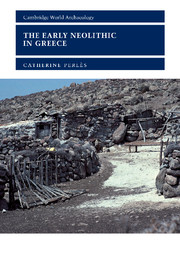Book contents
- Frontmatter
- Contents
- List of figures
- List of tables
- Acknowledgements
- Introduction
- 1 The land and its resources: the geographic context
- 2 The Mesolithic background
- 3 The introduction of farming: local processes, diffusion or colonization?
- 4 Foreign colonists: where from?
- 5 The earliest Neolithic deposits: ‘aceramic’, ‘pre-pottery’ or ‘ceramic’?
- 6 The spread of the Early Neolithic in Greece: chronological and geographical aspects
- 7 A case study in Early Neolithic settlement patterns: eastern Thessaly
- 8 Early Neolithic subsistence economy: the domestic and the wild
- 9 The Early Neolithic village
- 10 Craft specialization: the contrasting cases of chipped-stone tools, pottery and ornaments
- 11 A variety of daily crafts
- 12 Ritual interaction? The miniature world of ‘dolls or deities’
- 13 Interacting with the dead: from the disposal of the body to funerary rituals
- 14 Interactions among the living
- Conclusion
- Bibliography
- Index
6 - The spread of the Early Neolithic in Greece: chronological and geographical aspects
Published online by Cambridge University Press: 18 December 2009
- Frontmatter
- Contents
- List of figures
- List of tables
- Acknowledgements
- Introduction
- 1 The land and its resources: the geographic context
- 2 The Mesolithic background
- 3 The introduction of farming: local processes, diffusion or colonization?
- 4 Foreign colonists: where from?
- 5 The earliest Neolithic deposits: ‘aceramic’, ‘pre-pottery’ or ‘ceramic’?
- 6 The spread of the Early Neolithic in Greece: chronological and geographical aspects
- 7 A case study in Early Neolithic settlement patterns: eastern Thessaly
- 8 Early Neolithic subsistence economy: the domestic and the wild
- 9 The Early Neolithic village
- 10 Craft specialization: the contrasting cases of chipped-stone tools, pottery and ornaments
- 11 A variety of daily crafts
- 12 Ritual interaction? The miniature world of ‘dolls or deities’
- 13 Interacting with the dead: from the disposal of the body to funerary rituals
- 14 Interactions among the living
- Conclusion
- Bibliography
- Index
Summary
The definitions of the Early Neolithic in Greece
The Early Neolithic is a phase of long duration, witnessing the expansion of farming over Greece and the multiplication of large sedentary villages. Besides the first widespread presence of pottery, it is characterized by well-built houses, elaborate house equipment, long-distance circulation of goods and abundant evidence of symbolic expression. With the possible exception of its earliest stage, the Early Neolithic is not a ‘transitional’ or ‘formative’ phase. On the contrary, it sets the stage for what will prove to be, in its fundamental structures, a remarkably stable socioeconomic organization throughout the Neolithic.
The Early Neolithic is classically defined on the basis of its pottery, with the predominance of small and medium-sized open bowls, often monochrome and well burnished, more rarely decorated with simple painted patterns or with impressions. Low ring feet are a common feature. The Early Neolithic starts with the first relatively abundant ceramic production (Monochrome phase) and ends with the appearance of characteristic Middle Neolithic (MN) ware, the Urfirnis in the Peloponnese or the Sesklo ware in Thessaly for instance.
Despite marked differences in the ceramic productions, the Early Neolithic was not immediately distinguished from the Middle Neolithic. Tsountas (1908), followed by Wace and Thompson (1912), divided the Thessalian Neolithic into two periods only, corresponding to the present-day Sesklo (MN) and Dimini or Late Neolithic (LN) cultures. Tsountas had, however, already recognized the specificity of the earliest monochrome wares at Sesklo (Tsountas 1908: 159–60).
- Type
- Chapter
- Information
- The Early Neolithic in GreeceThe First Farming Communities in Europe, pp. 98 - 120Publisher: Cambridge University PressPrint publication year: 2001



